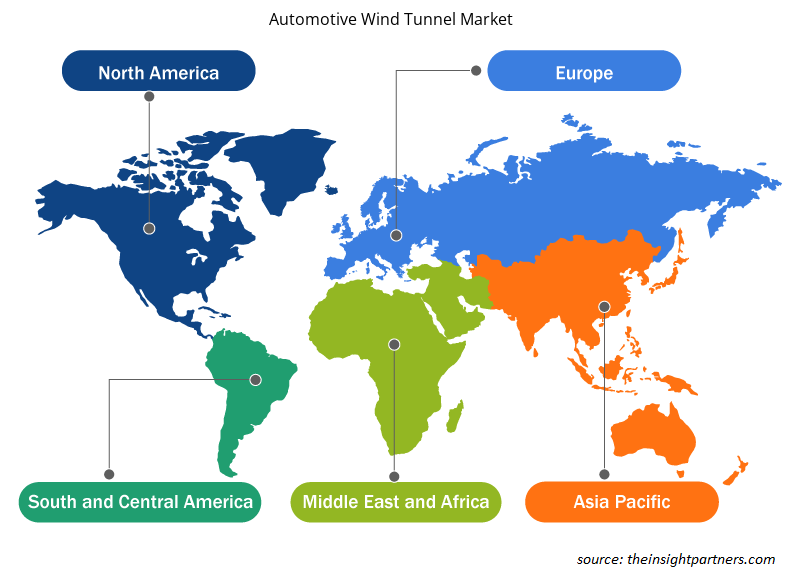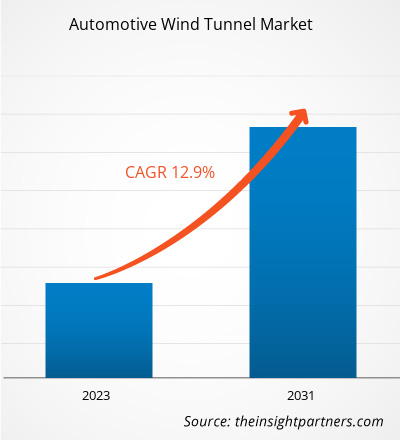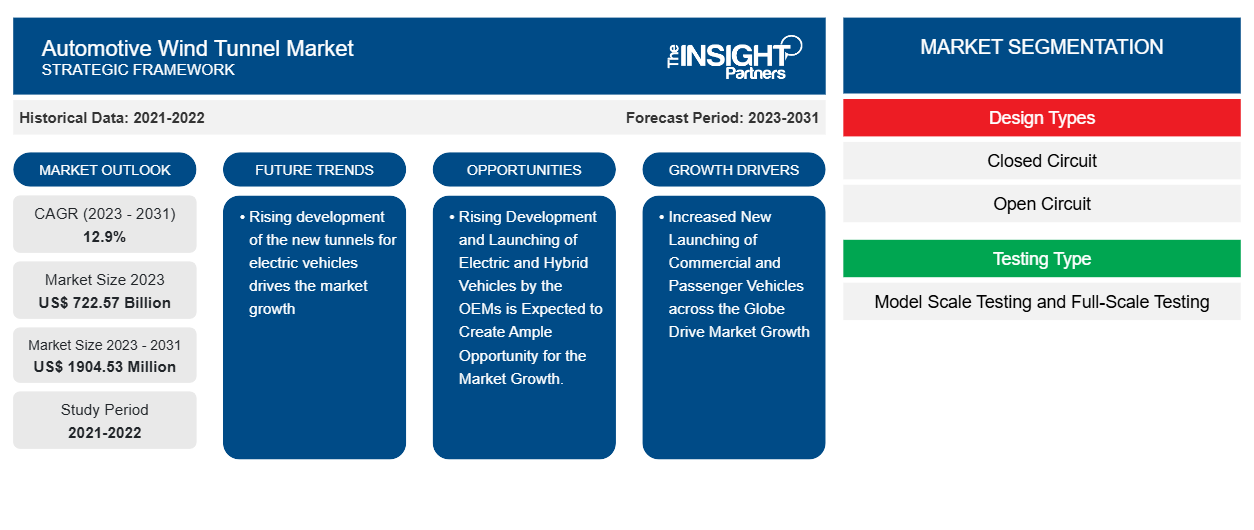Si prevede che le dimensioni del mercato delle gallerie del vento per autoveicoli raggiungeranno 1904,53 milioni di dollari entro il 2031, rispetto ai 722,57 miliardi di dollari del 2023. Si prevede che il mercato registrerà un CAGR del 12,9% nel 2022-2031. Una galleria del vento per autoveicoli è un ambiente controllato progettato per simulare le condizioni del vento naturale per valutare le prestazioni aerodinamiche dei veicoli. L'aumento delle vendite e della produzione di autoveicoli in tutto il mondo sta guidando la crescita del mercato durante il periodo di previsione. Secondo l'Organizzazione internazionale dei costruttori di veicoli a motore, le vendite di veicoli commerciali in tutto il mondo hanno raggiunto 27,45 milioni di unità nel 2023, con un aumento dell'11,7% rispetto al 2022. I test sui veicoli commerciali utilizzano gallerie del vento per autoveicoli per testare l'aerodinamica dei veicoli.CAGR of 12.9% in 2022–2031. An automotive wind tunnel is a controlled environment designed for simulating natural wind conditions to evaluate the aerodynamic performance of vehicles. Increasing automotive sales and production across the globe is driving the market growth during the forecast period. According to the International Organization of Motor Vehicle Manufacturers, commercial vehicle sales around the globe reached 27.45 million units in 2023, increased by 11.7% compared to 2022. Commercial vehicle testing utilizes automotive wind tunnels in order to test the aerodynamics of the vehicles.
Analisi del mercato delle gallerie del vento per l'automotive
Il mercato delle gallerie del vento per autoveicoli è guidato dall'aumento della produzione automobilistica con l'impennata delle vendite di nuovi veicoli in tutto il mondo. Secondo l'Organizzazione internazionale dei costruttori di veicoli a motore, le vendite di automobili hanno raggiunto 92,72 milioni di unità nel 2023, con un aumento del 10,6% rispetto al 2022. Tale crescita nelle vendite di automobili è dovuta principalmente al crescente reddito disponibile delle persone che hanno creato una domanda enorme per il mercato delle gallerie del vento per autoveicoli durante il periodo di previsione.
Inoltre, il crescente lancio di nuovi veicoli da parte dei principali OEM in tutto il mondo ha creato una domanda enorme per la crescita del mercato delle gallerie del vento per autoveicoli durante il periodo di previsione.OEMs across the globe has created massive demand for the automotive wind tunnel market growth during the forecast period.
Panoramica del mercato delle gallerie del vento per autoveicoli
Una galleria del vento per autoveicoli Una galleria del vento in genere comprende una sezione di prova in cui un modello o un veicolo può essere montato e visualizzato mentre l'aria viene soffiata o, più comunemente, aspirata da una ventola o da una serie di ventole. Alcuni degli elementi chiave che ci distinguono da quasi tutte le altre gallerie del vento nel mondo sono l'uso della nostra strada a rulli e del sistema di movimento del modello integrato (beccheggio, rollio, imbardata, sollevamento e sterzata delle ruote anteriori automatizzati), che consente test più realistici. Cercando continuamente lo strumento di test perfetto, ARC si impegna a far evolvere la sua tecnologia di galleria del vento per seguire i miglioramenti della tecnologia. Una galleria può testare modelli in scala fino al 50% che replicano veicoli da corsa, di produzione, commerciali e militari a grandezza naturale con un livello di dettaglio molto elevato. Una galleria del vento è uno dei componenti chiave che aiuta a distinguere la galleria del vento da quasi tutte le gallerie del vento disponibili in commercio nel mondo. All'inizio della sezione stradale c'è una scatola di aspirazione per garantire il corretto flusso dello strato limite lungo l'intera strada.
Personalizza questo report in base alle tue esigenze
Riceverai la personalizzazione gratuita di qualsiasi report, comprese parti di questo report, o analisi a livello nazionale, pacchetto dati Excel, oltre a usufruire di grandi offerte e sconti per start-up e università
- Scopri le principali tendenze di mercato in questo rapporto.Questo campione GRATUITO includerà analisi di dati che spaziano dalle tendenze di mercato alle stime e alle previsioni.
Driver e opportunità del mercato delle gallerie del vento per l'automotive
L'aumento dei nuovi lanci di veicoli commerciali e passeggeri in tutto il mondo stimola la crescita del mercato
L'aumento del lancio di nuovi veicoli da parte degli OEM in tutto il mondo è il principale fattore trainante per la crescita del mercato delle gallerie del vento per l'automotive durante il periodo di previsione. Ad esempio, a dicembre 2023, il BMW Group ha pianificato di lanciare mini-SUV in India per il 2024. La nuova serie include sia varianti elettriche che ICE. I nuovi lanci di BMW includono la X1 e la BMW Serie 7 e i modelli SUV X5 e X7 aggiornati. Tale lancio di nuovi veicoli richiede diversi test prima di essere immessi sul mercato. I test sui veicoli richiedono la galleria del vento per l'automotive per fornire le classificazioni di sicurezza dei veicoli.OEMs across the globe is the major driving factor for the automotive wind tunnel market growth during the forecast period. For instance, in December 2023, BMW Group planned to launch mini-SUVs in India for 2024. The new series includes both electric and ICE variants. BMW's new launches include the X1 and the BMW 7 Series, and the updated X5 and X7 SUV models. Such new vehicle launching requires several tests before launching into the market. The vehicle testing requires automotive wind tunnel to provide the safety ratings of the vehicles.
Le gallerie del vento per autoveicoli sono ampiamente utilizzate per i test aerodinamici dei veicoli. Diversi produttori di veicoli utilizzano le gallerie del vento per replicare i test sui veicoli nel mondo reale per i loro modelli di veicoli e i test sulle mule car. I test nelle gallerie del vento per auto forniscono un modo convalidato per simulare i dati del modello delle auto e consentono all'ingegnere di misurare l'effetto acustico dei trattamenti di riduzione del rumore nei veicoli.
I veicoli passeggeri e i veicoli commerciali ad alta velocità dipendono in particolar modo dal rumore aerodinamico. Le misurazioni del rumore aerodinamico negli interni delle auto vengono condotte su veicoli full-size in gallerie del vento in varie fasi di sviluppo, poiché il rumore aerodinamico è la fonte primaria di rumore nelle auto a velocità di crociera e più elevate.
Si prevede che il crescente sviluppo e lancio di veicoli elettrici e ibridi da parte degli OEM creerà ampie opportunità di crescita del mercato.OEMs is Expected to Create Ample Opportunity for the Market Growth.
L'emergere di veicoli elettrici in tutto il mondo, insieme alla crescente vendita di questi veicoli, ha creato una domanda enorme per il mercato delle gallerie del vento per autoveicoli da parte degli OEM. I produttori di automobili stanno utilizzando questo tipo di galleria del vento per testare l'aerodinamica dei veicoli. I produttori di veicoli elettrici sono tenuti a soddisfare determinati test per analizzare le prestazioni di sicurezza dei veicoli. Il crescente lancio di questi veicoli elettrici e ibridi da parte dei principali OEM in tutto il mondo dovrebbe creare ampie opportunità per la crescita del mercato delle gallerie del vento per autoveicoli durante il periodo di previsione. Ad esempio, nel 2023, Tata Motors Ltd. ha lanciato il veicolo elettrico Tata Punch come autovettura per i consumatori indiani. L'azienda ha lanciato questi veicoli per soddisfare le normative governative ecocompatibili e ridurre le emissioni di carbonio. Questo test sui veicoli richiede gallerie del vento per autoveicoli per testare l'aerodinamica dei veicoli.
Analisi della segmentazione del rapporto di mercato sulle gallerie del vento per autoveicoli
I segmenti chiave che hanno contribuito alla derivazione dell'analisi del mercato delle gallerie del vento per autoveicoli sono tipologia, piattaforma, applicazione e utente finale.
- In base alla tipologia di progettazione, il mercato si divide in circuiti chiusi e circuiti aperti.
- In base al tipo di test, il mercato globale delle gallerie del vento per autoveicoli si divide in test su scala modello e test su scala reale.
- In base all'applicazione, il mercato è suddiviso in autovetture, veicoli commerciali e motocicli.
Analisi della quota di mercato delle gallerie del vento per l'automotive per area geografica
L'ambito geografico del rapporto sul mercato delle gallerie del vento per autoveicoli è suddiviso principalmente in cinque regioni: Nord America, Europa, Asia Pacifico, Medio Oriente e Africa e Sud America.
Si prevede che l'Asia Pacifica deterrà la quota maggiore nel 2023. Ciò è dovuto principalmente alla crescente domanda da parte degli OEM del settore automobilistico di testare l'aerodinamica dei veicoli. Diversi OEM in questa regione stanno lanciando nuovi veicoli per soddisfare la crescente domanda dei consumatori di veicoli nuovi e avanzati basati sulla tecnologia.
Il Nord America sta crescendo a un ritmo rapido per il mercato delle gallerie del vento per autoveicoli nel 2023. Ciò è dovuto principalmente all'aumento della produzione di veicoli commerciali e al lancio da parte degli OEM in questa regione. Secondo l'Organizzazione internazionale dei costruttori di veicoli a motore (OICA), le vendite di veicoli commerciali hanno raggiunto 10,4 milioni di unità nel 2022 e sono aumentate di 9,7 milioni rispetto all'anno precedente, il 2021. Inoltre, la domanda per il mercato delle gallerie del vento per autoveicoli è guidata dal crescente lancio di nuovi veicoli da parte dei principali produttori di marchi automobilistici del Nord America. I produttori includono Ford Motor Co., General Motors Co., Rivian Automotive Inc., Tesla Inc., PACCAR Inc., Navistar International Corp e BMW AG. Questi proprietari di marchi di veicoli premium utilizzano gallerie del vento per i test aerodinamici dei veicoli.
Questa ricerca ha fatto riferimento a varie fonti di dati, quali l'Organizzazione Internazionale dei Costruttori di Veicoli a Motore, la Transmission Rebuilders Network Worldwide, l'Automatic Transmission Rebuilders Association (ATRA), l'Automotive Service Association (ASA), l'Automotive Aftermarket Association Southeast (AAAS) e varie organizzazioni automobilistiche in diversi Paesi.Rebuilders Network Worldwide, Automatic Transmission Rebuilders Association (ATRA), Automotive Service Association (ASA), Automotive Aftermarket Association Southeast (AAAS), and various automotive organizations in different countries.
Approfondimenti regionali sul mercato delle gallerie del vento per l'automotive
Le tendenze regionali e i fattori che influenzano il mercato Automotive Wind Tunnel durante il periodo di previsione sono stati ampiamente spiegati dagli analisti di Insight Partners. Questa sezione discute anche i segmenti e la geografia del mercato Automotive Wind Tunnel in Nord America, Europa, Asia Pacifico, Medio Oriente e Africa e America meridionale e centrale.

- Ottieni i dati specifici regionali per il mercato delle gallerie del vento per autoveicoli
Ambito del rapporto sul mercato delle gallerie del vento per l'automotive
| Attributo del report | Dettagli |
|---|---|
| Dimensioni del mercato nel 2023 | 722,57 miliardi di dollari USA |
| Dimensioni del mercato entro il 2031 | 1904,53 milioni di dollari USA |
| CAGR globale (2023-2031) | 12,9% |
| Dati storici | 2021-2022 |
| Periodo di previsione | 2023-2031 |
| Segmenti coperti | Per tipi di progettazione
|
| Regioni e Paesi coperti | America del Nord
|
| Leader di mercato e profili aziendali chiave |
|
Densità degli attori del mercato: comprendere il suo impatto sulle dinamiche aziendali
Il mercato Automotive Wind Tunnel Market sta crescendo rapidamente, spinto dalla crescente domanda degli utenti finali dovuta a fattori quali l'evoluzione delle preferenze dei consumatori, i progressi tecnologici e una maggiore consapevolezza dei vantaggi del prodotto. Con l'aumento della domanda, le aziende stanno ampliando le loro offerte, innovando per soddisfare le esigenze dei consumatori e capitalizzando sulle tendenze emergenti, il che alimenta ulteriormente la crescita del mercato.
La densità degli operatori di mercato si riferisce alla distribuzione di aziende o società che operano in un particolare mercato o settore. Indica quanti concorrenti (operatori di mercato) sono presenti in un dato spazio di mercato in relazione alle sue dimensioni o al valore di mercato totale.
Le principali aziende che operano nel mercato delle gallerie del vento per autoveicoli sono:
- Mahle GmbH
- Società Agricola Daimler
- MIRA DI HORIBA
- Industrie pesanti Mitsubishi
- Galleria del vento A2
- Audi
Disclaimer : le aziende elencate sopra non sono classificate secondo un ordine particolare.

- Ottieni una panoramica dei principali attori del mercato delle gallerie del vento per autoveicoli
Notizie e sviluppi recenti sul mercato delle gallerie del vento per l'automotive
Il mercato Automotive Wind Tunnel viene valutato raccogliendo dati qualitativi e quantitativi dopo la ricerca primaria e secondaria, che include importanti pubblicazioni aziendali, dati associativi e database. Di seguito è riportato un elenco degli sviluppi nel mercato per il mercato Automotive Wind Tunnel e le strategie:
- A maggio 2022, Honda ha lanciato una nuova galleria del vento del valore di 124 milioni di dollari in Ohio, USA, per mettere a punto e testare le auto da corsa. Le auto che corrono all'Indianapolis Motor Speedway venivano testate nella galleria del vento dell'azienda. (Fonte: Flyability, comunicato stampa/sito Web aziendale/newsletter)
Copertura e risultati del rapporto sul mercato delle gallerie del vento per l'automotive
Il rapporto "Dimensioni e previsioni del mercato delle gallerie del vento per l'automotive (2021-2031)" fornisce un'analisi dettagliata del mercato che copre le seguenti aree:
- Dimensioni e previsioni del mercato a livello globale, regionale e nazionale per tutti i segmenti di mercato chiave coperti dall'ambito
- Dinamiche di mercato come fattori trainanti, vincoli e opportunità chiave
- Principali tendenze future
- Analisi dettagliata delle cinque forze di Porter
- Analisi di mercato globale e regionale che copre le principali tendenze di mercato, i principali attori, le normative e gli sviluppi recenti del mercato
- Analisi del panorama industriale e della concorrenza che copre la concentrazione del mercato, l'analisi della mappa di calore, i principali attori e gli sviluppi recenti
- Profili aziendali dettagliati con analisi SWOT
- Analisi storica (2 anni), anno base, previsione (7 anni) con CAGR
- Analisi PEST e SWOT
- Valore/volume delle dimensioni del mercato - Globale, Regionale, Nazionale
- Industria e panorama competitivo
- Set di dati Excel
Report recenti
Rapporti correlati
Testimonianze
Motivo dell'acquisto
- Processo decisionale informato
- Comprensione delle dinamiche di mercato
- Analisi competitiva
- Analisi dei clienti
- Previsioni di mercato
- Mitigazione del rischio
- Pianificazione strategica
- Giustificazione degli investimenti
- Identificazione dei mercati emergenti
- Miglioramento delle strategie di marketing
- Aumento dell'efficienza operativa
- Allineamento alle tendenze normative





















 Ottieni un campione gratuito per - Mercato delle gallerie del vento per autoveicoli
Ottieni un campione gratuito per - Mercato delle gallerie del vento per autoveicoli